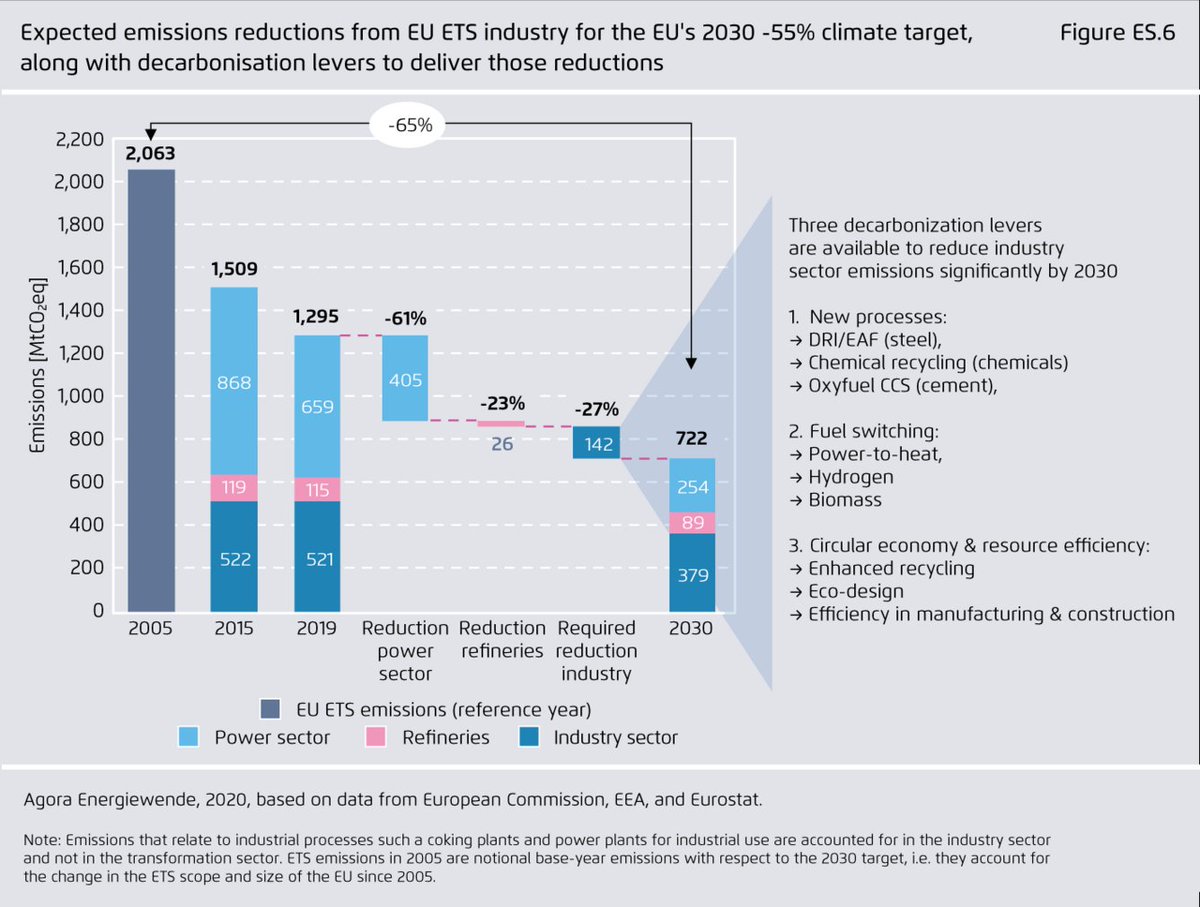
1/ What’s the future of ammonia production in 🇪🇺? Replacing grey H2 with green H2 and the job is done? Unfortunately, it’s not as simple as that. Will BECCS be an option? Some initial thoughts and questions.
#industrydecarbonizationtwitter feedback/discussion very welcome! #H2
#industrydecarbonizationtwitter feedback/discussion very welcome! #H2

2/ Ammonia (NH3) is produced at a few dozen sights in Europe and responsible for 1/5 (24 MtCO2) of the CO2 emissions of the EU chemical industry. Ammonia is used for many different products of the chemical industry, but the vast majority goes into the production of fertilizers.
3/ At first sight the decarbonization of NH3 seems like a very straightforward thing: replacing the grey H2 from steam methane reforming (SMR) in existing plants by green H2. Unfortunately it’s not as simple… This bears questions for a transformation pathway of existing EU NH3.
4/ Issue No. 1: Pressure on existing ammonia production in the coming decade.
The EU fertilizer regulation requires all member states to reduce the surplus nitrogen amounts in soils, which is a big problem in many EU member states.
The EU fertilizer regulation requires all member states to reduce the surplus nitrogen amounts in soils, which is a big problem in many EU member states.
5/ This surplus nitrogen stems from an overfertilization in agriculture. In general, there are two kinds of fertilizers: livestock manure and NH3-based mineral fertilizers.
6/ The amount of livestock manure is directly tied to the number of livestock and thus tied to meat/dairy consumption. Reducing this is desirable, but politically a highly sensitive topic -> EU fertilizer regulation will cut sharply into the use of NH3-based mineral fertilizers.
7/ Issue No. 2: Within existing NH3 plants with an integrated SMR, it's possible to blend in 10-20% of green H2 without major retrofits of the plant. However, going beyond this, the lower utilization of SMR means that the required yield ratio of nitrogen/H2 cannot be maintained.
8/ This would require the costly construction of an additional air separation unit to get sufficient nitrogen for the process. But in the long-run such a plant would probably not be able to compete with new ammonia plants that are designed for the efficient use of 100% green H2.
9/ Issue No. 3: What are future markets for green ammonia and who can produce green ammonia at competitive prices? It’s still unclear in which applications we will see green ammonia in the future. Apart from existing use applications today, there could be new markets.
10/ These new markets for green ammonia could be:
-fuel for maritime transport
-fuel in the power sector
-NH3 as carrier for green H2 transport via ships
Regarding option 3: You obviously wouldn't reconvert NH3 to H2 to produce NH3 in Europe again...
-fuel for maritime transport
-fuel in the power sector
-NH3 as carrier for green H2 transport via ships
Regarding option 3: You obviously wouldn't reconvert NH3 to H2 to produce NH3 in Europe again...
11/ However, it is clear that in these new commodity markets the price for green ammonia will be the decisive factor whether a green ammonia plant can compete in the long-run against other regions with cheap renewables/green H2 supply. What does this mean for existing plants?
12/ Should new NH3 plants designed for 100% green H2 be built in the EU in the coming decade? It depends where in Europe. In some countries that will have access to comparatively cheap green H2 this is happening already, as recent announcements show: Yara,🇳🇴 and Iberdrola, 🇪🇸. 

13/ For existing NH3 production in continental Europe the question is whether they can get access to sufficiently cheap green H2 in the future to compete on these new markets. If the answer is no, maybe there could be an entirely different route to cost-competitive green NH3…
14/ BECCS-NH3: Biomethane can be used in existing SMR. The very pure biogenic CO2 stream is suitable for CCS to generate negative emissions. This add. revenue stream for the neg. emissions could potentially make such a green NH3 production competitive. What are the pros and cons?
15/ All major studies show that neg. emissions are needed to achieve the goals of the Paris Agreement. In a recent study, we also found that for climate neutrality in 🇩🇪, negative emissions via BECCS are necessary to overcompensate unavoidable residual emissions of agriculture. 

16/ Such a BECCS pathway may also be flexible:
Either start with biomethane first and only connect the NH3 plant to a CO2-infrastructure once it becomes available or start with blue NH3 via CCS and switching to biomethane later once sufficient amounts are available.
Either start with biomethane first and only connect the NH3 plant to a CO2-infrastructure once it becomes available or start with blue NH3 via CCS and switching to biomethane later once sufficient amounts are available.
17/ There are many open questions when it comes to the future of NH3 in Europe and the debate is a moving picture. This is an attempt to initiate a discussion, as there is certainly much to learn from the collective wisdom of experts here. Feedback and discussions very welcome.
@gnievchenko, @Ma_Deutsch @andreasgraf @RENEWIndustry @bataille_chris @JMGlachant @ReisPiero @THEnergyNet @WiGH_network @janeksteitz @manuelberkel @MatildaAxelson
• • •
Missing some Tweet in this thread? You can try to
force a refresh




